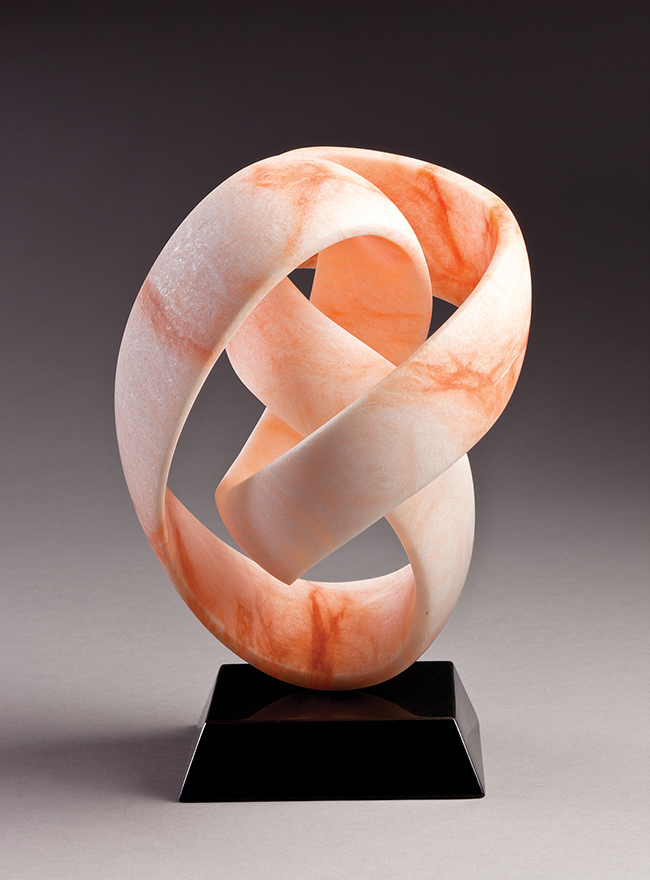Somers Randolph knew he wanted to be a sculptor at 15. That early decision shaped a life devoted to the pursuit of form. His work, primarily in stone, reflects decades of exploration into balance, proportion, and motion.

Randolph’s sculptures often evoke a sense of movement that feels almost paradoxical given the solidity of his medium. One of his beautiful creations is a twisted ribbon carved from pink marble. The piece embodies grace and precision, showcasing his ability to transform rigid material into something that seems light and flowing. His craftsmanship is undeniable, with smooth, sinuous lines that make the viewer forget they are looking at stone.
What stands out in Randolph’s approach is his relationship with inspiration. He speaks of it as a rare, fleeting phenomenon—moments of ecstatic knowledge that fuel long stretches of labor. For Randolph, those flashes of insight are precious, and he feels fortunate to have experienced them throughout his career.
He talks about making each piece perfect in relation to itself. This isn’t about creating something flawless by external standards. It’s about achieving internal harmony within the sculpture—a balance between weight and motion, a silhouette that feels complete. His sculptures are not about answering questions but making statements, a shift he’s noticed in his work as he approaches 70.
Over the years, Randolph’s art has become simpler, more refined. He’s pared down forms to their essence, creating pieces that convey a quiet, assured presence. There’s a clarity to his later work that suggests a deep understanding of his craft and an acceptance of the limitations of time.
“There will not be enough time for me to do all I want to do,” he says. It’s a sentiment that speaks to the urgency many artists feel. The creative drive doesn’t diminish with age; if anything, it intensifies. The realization that time is finite pushes Randolph to focus more on his artistic vision, ensuring that each piece matters.
Randolph’s choice of stone as a medium is significant. Stone is ancient and enduring, but it’s also unforgiving. Mistakes can’t be easily corrected. Working with stone requires patience, precision, and respect for the material’s natural properties. Randolph has spent decades honing his technique, learning how to coax fluidity from an inherently rigid substance.
His work resonates with a timeless quality. There’s no reliance on trends or fleeting styles. Instead, Randolph’s sculptures are grounded in universal principles of form and balance. They invite viewers to slow down, to observe the interplay of curves and lines, light and shadow.
In the twisted pink marble ribbon, for example, there’s a playfulness that belies the labor involved. It’s a piece that captures the joy of movement—a swirl frozen in time. The craftsmanship is evident in every curve and polished surface, a testament to Randolph’s dedication.
Randolph’s journey as a sculptor has been one of continuous learning. He’s never settled for repeating past successes. Each new piece presents a challenge, a chance to push his skills further. This commitment to growth is part of what makes his work feel so alive. There’s a sense of evolution in his sculptures, a reflection of his own development as an artist and person.
As he reflects on his career, Randolph acknowledges the importance of those fleeting moments of inspiration. But he also recognizes that much of his work is grounded in persistence—the daily act of showing up, of engaging with the stone, of striving to create something meaningful. It’s a balance between vision and discipline, between dreaming and doing.
For viewers, Randolph’s sculptures offer a moment of pause in a fast-paced world. They encourage contemplation, a reminder that beauty can be found in stillness and simplicity. His work invites people to look beyond the surface, to appreciate the intricacies of form and the skill required to achieve such harmony.
Somers Randolph’s art is a quiet conversation between artist and material, between movement and stillness. His sculptures stand as lasting reminders of the power of form to communicate, to inspire, and to endure.

